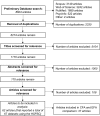Hospital Survey on Patient Safety Culture (HSPSC): a systematic review of the psychometric properties of 62 international studies
- PMID: 31488465
- PMCID: PMC6731893
- DOI: 10.1136/bmjopen-2018-026896
Hospital Survey on Patient Safety Culture (HSPSC): a systematic review of the psychometric properties of 62 international studies
Abstract
Objective: To carry out a systematic review of the psychometric properties of international studies that have used the Hospital Survey on Patient Safety Culture (HSPSC).
Design: Literature review and an analysis framework to review studies.
Setting: Hospitals and other healthcare settings in North and South America, Europe, the Near East, the Middle East and the Far East.
Data sources: A total of 62 studies and 67 datasets made up of journal papers, book chapters and PhD theses were included in the review.
Primary and secondary outcome measures: Psychometric properties (eg, internal consistency) and sample characteristics (eg, country of use, participant job roles and changes made to the original version of the HSPSC).
Results: Just over half (52%) of the studies in our sample reported internal reliabilities lower than 0.7 for at least six HSPSC dimensions. The dimensions 'staffing', 'communication openness', 'non-punitive response to error', 'organisational learning' and 'overall perceptions of safety' resulted in low internal consistencies in a majority of studies. The outcomes from assessing construct validity were reported in 60% of the studies. Most studies took place in a hospital setting (84%); the majority of survey participants (62%) were drawn from nursing and technical staff. Forty-two per cent of the studies did not state what modifications, if any, were made to the original US version of the instrument.
Conclusions: While there is evidence of a growing worldwide trend in the use of the HSPSC, particularly within Europe and the Near/Middle East, our review underlines the need for caution in using the instrument. Future use of the HSPSC needs to be sensitive to the demands of care settings, the target population and other aspects of the national and local healthcare contexts. There is a need to develop guidelines covering procedures for using, adapting and translating the HSPSC, as well as reporting findings based on its use.
Keywords: international studies; patient safety culture; psychometrics.
© Author(s) (or their employer(s)) 2019. Re-use permitted under CC BY-NC. No commercial re-use. See rights and permissions. Published by BMJ.
Conflict of interest statement
Competing interests: None declared.
Figures



References
-
- Catchpole K, Hadi M, Morgan L, et al. Human factors and ergonomics in surgical safety: that was then, this is now : Albolino S, Bagnara S, Bellandi T, et al., Healthcare Ergonomics and patient safety 2011. CRC Press, Taylor and Francis, 2011.
-
- Wears RL, Sutcliffe KM, Van Rite E. Patient safety: a brief but spirited history : Patient safety: perspectives on evidence, information and knowledge transfer. Gower Publishing: Surrey, 2016: 1–21.
-
- Carayon P. Human Factors and Ergonomics in Health Care and Patient Safety. Boca Raton: CRC Press, 2012.
Publication types
MeSH terms
LinkOut - more resources
Full Text Sources
Medical
Molecular Biology Databases
